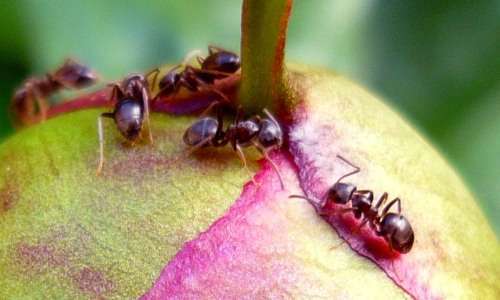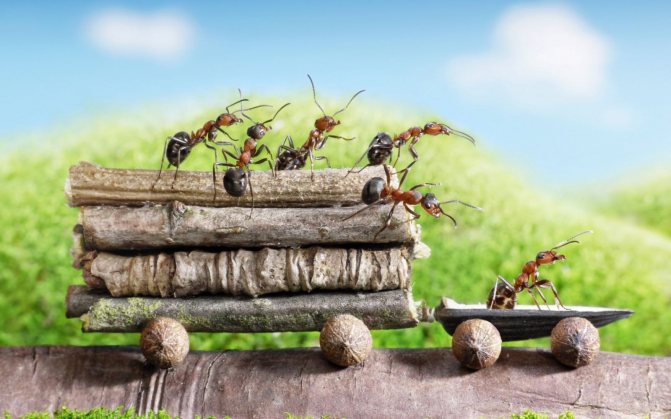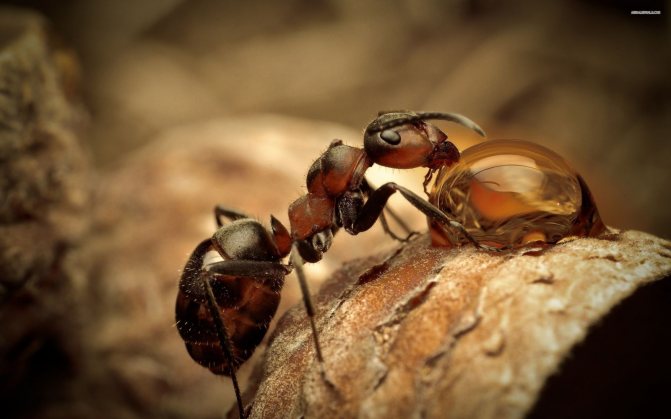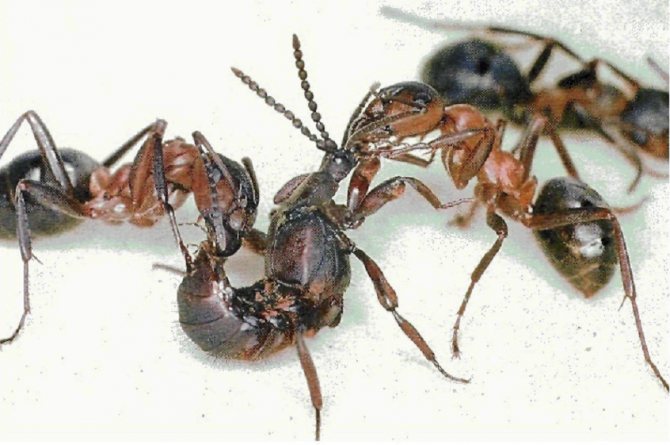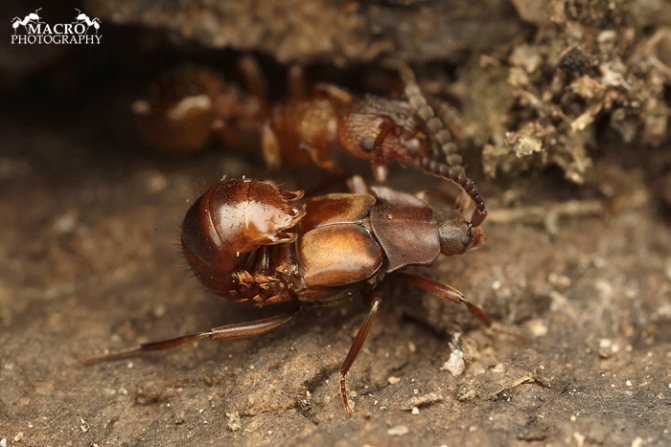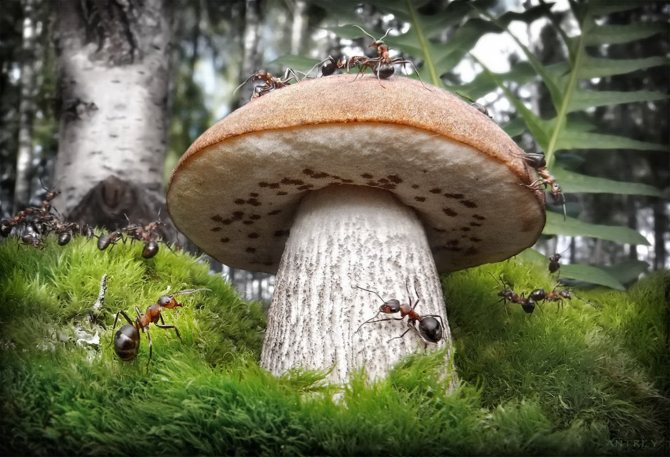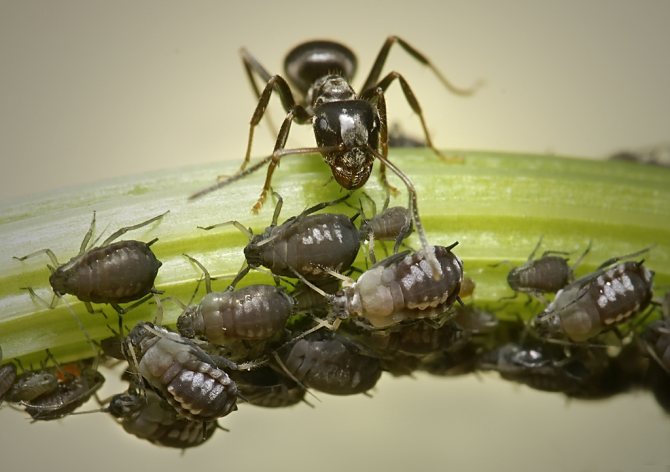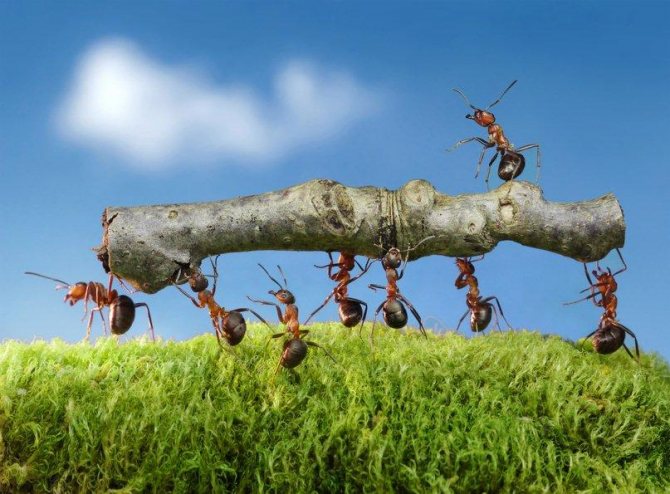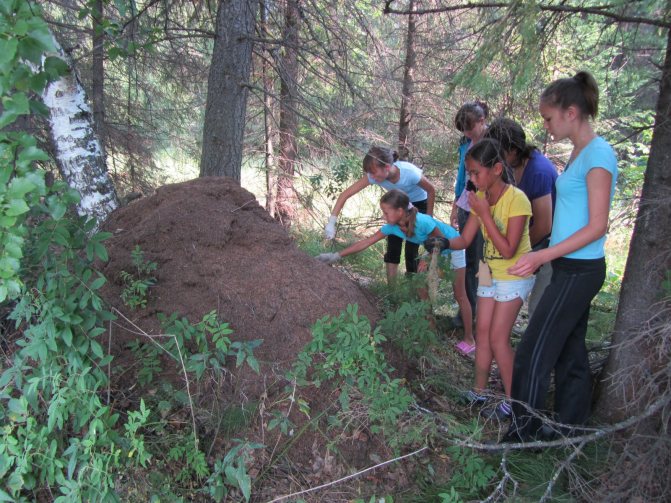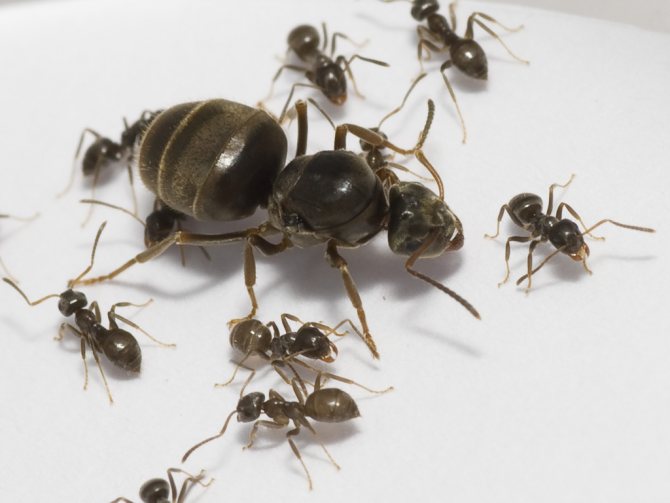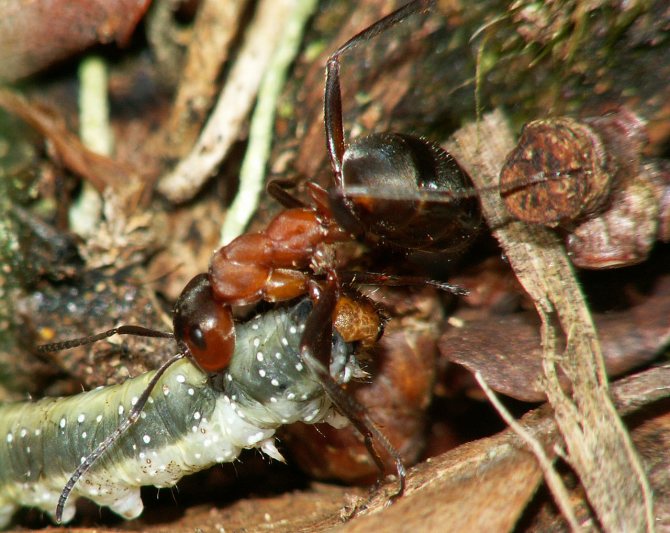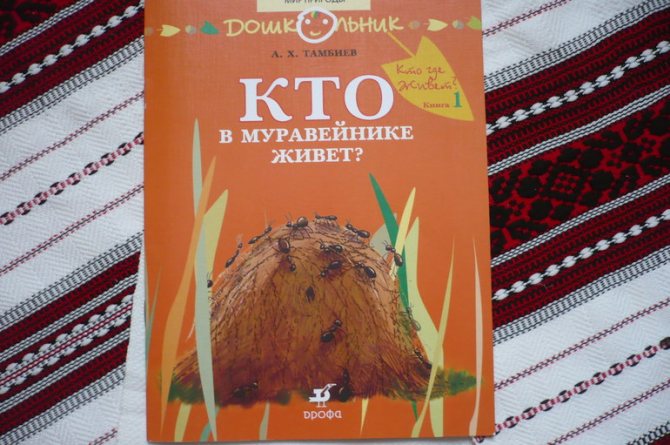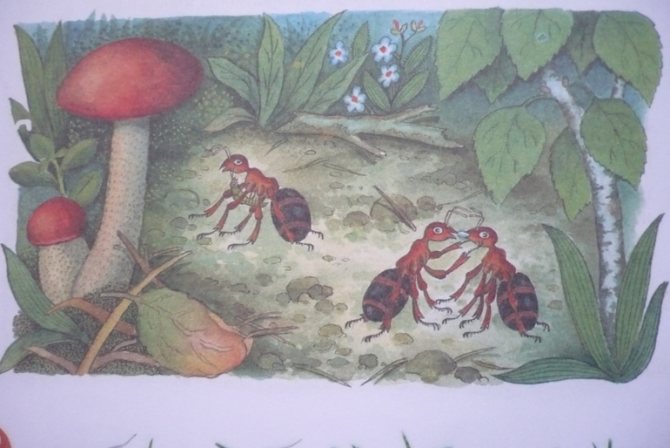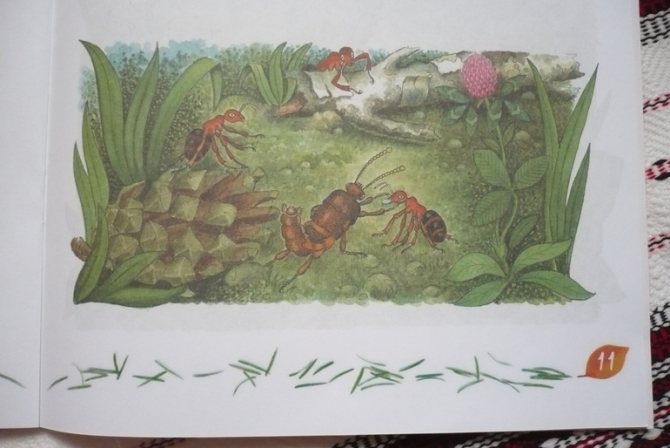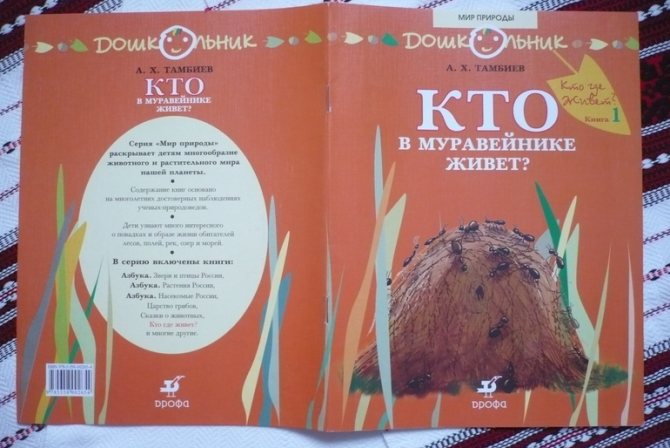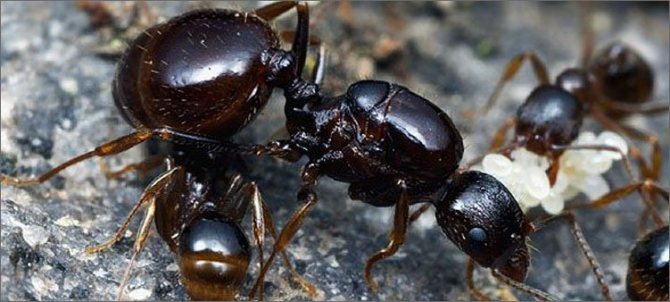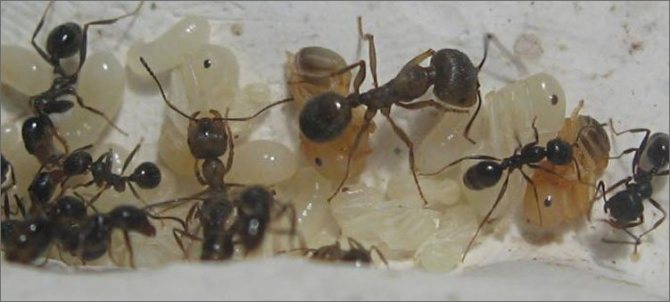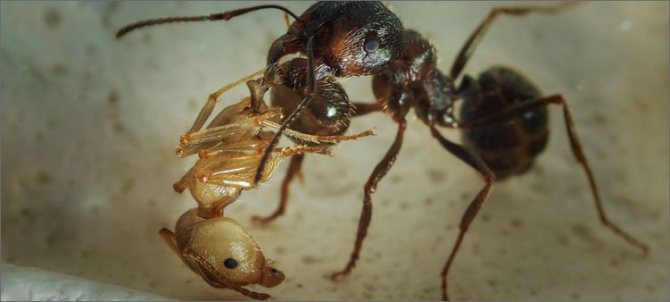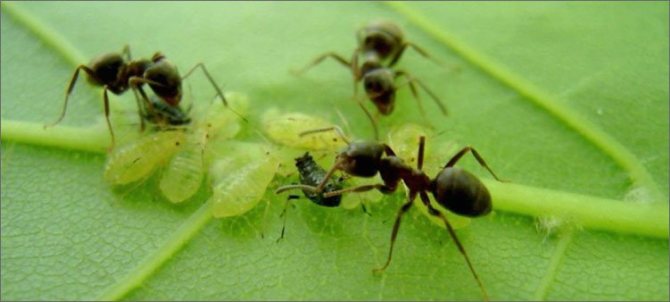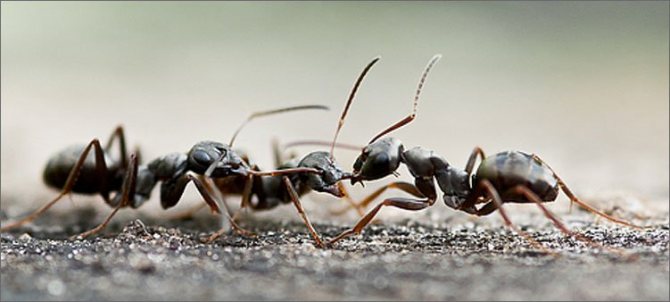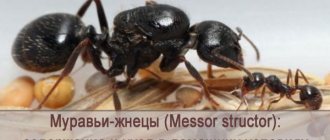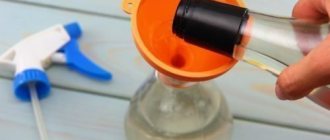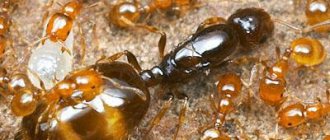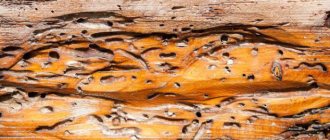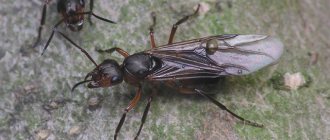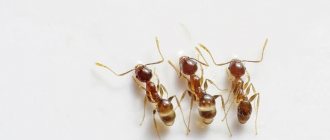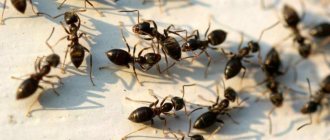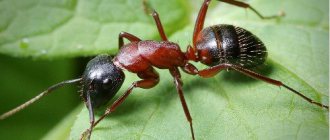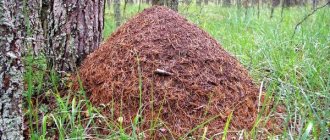"... They are very much like us, they grow mushrooms, breed aphids like cash cows, send soldiers to war, spray chemicals to frighten the enemy, take prisoners, use child labor and constantly exchange information ..."
Greetings, dear readers. Who do you think these lines are about? And all this, like a society of people, a large army of ants can do. A family of millions is so self-organized and well-coordinated in work that any modern leader can envy her.
Today, in simple language, understandable for children, we will try to tell you how an anthill works.
How strong are ants and how much weight do they lift?
The insect has a huge reserve of endurance - an ant can lift and carry 50 times its own weight. Moreover, if several individuals work together and combine their efforts, this indicator can increase manifold. This is possible due to the fact that the ant has a large percentage of muscles per unit of body weight.
The strength of ants allows them to successfully complete tasks of finding and preparing food. If the insect is not able to raise its prey, it can drag it along for a long time.
REFERENCE!
Many ants, connecting with their paws, can form long living bridges to overcome streams or crevices. Ligaments like these can support several kilograms.
Boric acid from ants
Boric (or orthoboric, H3BO3) acid is colorless and odorless crystalline flakes. It dissolves completely in water and is widely used in horticulture not only as a mineral fertilizer and a seed growth stimulator, but also became a real salvation in the fight against ants, since it is a deadly poison for arthropods.
Boric acid against garden ants is one of the most effective remedies. Its disinfecting and antibacterial properties make it possible to quickly and effectively destroy entire ant populations, and at the same time rid the beds of wood lice.
How to prepare an aqueous boric acid solution

Using boric acid against garden ants in a solution is not difficult. The main problem in how to get rid of pests with it is in its preparation, since crystalline scales do not dissolve well in water, and the solution, ideally, should be absolutely transparent and without sediment. In fact, the process of dissolving BA is quite simple and fast. The main thing is to know a few little tricks:
- 1 glass of hot water is poured into a small container and 5 g of boric powder is dissolved in it;
- add 2 tbsp to the water. l. honey or sugar;
- the volume of liquid in the container is adjusted to 0.5 l.
You need to water the anthill with sweet poisonous water. They do this late in the evening or at night, when the ants come to their "home". For greater effect, a little liquid is poured into flat containers and placed on ant paths.
How to cook food with boric acid for ants
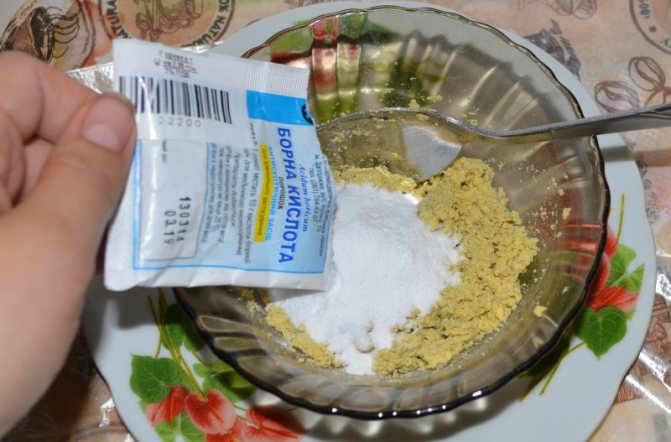

Boric acid alone will not work against garden ants. Since it has no color, taste or smell, it will not interest insects. Therefore, it is added to the "formic" food. Consider folk recipes that will help you get rid of six-legged pests for a long time using boric acid:
- Minced meat (4 tbsp.l.), boric acid (10 g) and a small amount of salt, mix thoroughly. Divide the mass into small pieces and arrange them near the anthill. For ants, meat is a delicacy. They will definitely eat it or drag it to the anthill to feed their relatives.
- From three boiled potatoes and three egg yolks, make mashed potatoes, into which pour 10 g of boric acid and a teaspoon of granulated sugar. Mix the mixture well, roll up the balls and put them on the anthill.
- Any jam (1 tablespoon) and boric acid (10 g) are diluted in a glass of hot water. The sweet mixture is cooled and poured into shallow bowls, placed in the places of the greatest concentration of ants. You can do without water: 3 tbsp. l. mix very thick jam with 10 g of BC, and spread this sweet mixture near the ant paths and around the anthill.
It makes no sense to increase the concentration of H3BO3 in baits. The specified amount of garden ants is enough for the insect to die almost instantly.
Boric acid from insects will work effectively in any case, no matter what recipe you choose from the above. When it enters the body, it causes paralysis in the ant, which leads to its death. Its effect is enhanced by the fact that the members of the colony most often eat the poisoned insect and also die. But remember that a chemical is used to make soft, liquid and sticky baits.
The methods of using boric acid from ants in the garden and in the garden are also suitable for getting rid of domestic ants, centipedes and cockroaches.
Another recipe for ants in this video:
So, based on the above information, it can be seen that the old ways of fighting ants continue to work as before, which will undoubtedly help gardeners to rid their area of harmful insects.
Who is the main ant king?
All life in an anthill rests on on the queen.
She does not participate either in the protection of the anthill, or in the collection of food, however, it is this individual who is entrusted with the task of maintaining and increasing the number of the colony.
The uterus is a former female who has been fertilized by a male and was able to organize a new anthill
... In the process of growing the first population, they bite off their wings.
The uterus lives up to 20 years,
laying during this time up to 500 thousand eggs. As long as this individual is alive, the colony has every chance of recovery, no matter what losses it incurs.
The hierarchy of society is clearly established in the anthill. The whole settlement is headed by the uterus. The most numerous are workers who, depending on their preferences, can perform various tasks - finding food, scouting, caring for the uterus and eggs. Soldiers are individuals with large, powerful jaws that guard the anthill and foragers.
Ant society
The arrangement of the "social life" of an anthill is even more complicated than the arrangement of the life of a hive. Ants resemble humans in many ways. For example, slavery is widespread in some species. Ants attack someone else's anthill and steal pupae. Then they grew up in a strange anthill, the captives work for his good. It would seem what slavery, when the unfortunate workers, and so all their lives and do nothing but selflessly work for the good of the queen and the males. But usually ants work for the prosperity of their own species and their own colony. By the way, huge amazon ants specialize only in "military operations": only stolen slaves work for the benefit of the anthill.
There is also a more sophisticated way of seizing power. There are species of ants, the female of which is able to literally charm ants of another species. She comes to a foreign colony, and the workers simply give her their own queen to be torn apart, and subsequently serve as a guest.
There are more peaceful activities in the life of ants. So, for example, many species have mastered "cattle breeding".They guard and breed aphids or cicadas. Some species “roam”, constantly migrating and driving “herds” of aphids with them. Some ants have also mastered agriculture - they grow mushrooms.
Photo
Next, you will see a photo of the hierarchy of ants - from workers to soldiers:
Ants are social creatures. If an ant is isolated in a jar and even fed well, it will die anyway: from loneliness, understanding of its uselessness, from longing for family. According to entomologists, ants are social beings, and they have no life without a society of their own kind.
The anthill is a perfect architectural structure. The top 10 cm layer of sticks, pebbles, pine needles is an ideal roof. Such a roof does not allow moisture to pass through, does not rot: an excellent heat insulator. The "living" area of the anthill reaches 15 square meters. The number of rooms reaches one hundred.
Storage rooms for eggs, larvae and ant pupae are located under the dome. The main part of the anthill is underground. Its galleries up to 1.5-2 meters go deep and not only because of safety, but also for the sake of being able to extract water. In some underground chambers, food warehouses are located, in others live ants hang, storing honey in their goiter. Common rooms are for relaxation. There are waste bins, cemeteries, toilets.
The queen lives separately, surrounded by a retinue of ten worker ants. She alone lays up to 40,000 eggs per day. Insects take care of the home. They are protected from external encroachment by the anthill patrol zone, reaching a diameter of 10-12 meters.
All summer long, ants ventilate the rooms, in sunny weather they warm up the backs in the sun and run to the inner chambers in order to heat the rooms like heating devices. The anthill has strict discipline, distribution of roles and hierarchy. The queen rules all. Families are polygamous (one female in the nest) and monogamous. And in all families, winged ants appear at the same time - brides and grooms, regardless of the number of females. For the rest of the time, only girls appear - working individuals who do not produce offspring while the queen is alive, but they work in guards, in repairs and construction, fight with enemies and serve in intelligence, are engaged in foraging. The queen lives for 15-20 years, and the worker ants live for about 7 years. Males die after mating (they do not participate in the life of the anthill).
Information is transmitted by reading through the pheromones left by the sisters, feeling each other with antennae, and also by ultrasound. If one ant noticed a fire, in a second the whole colony is at the line of defense.
Once a year, in one day and one hour, thousands of winged ants, bred specifically for this day, fly out of all the anthills of the forest. Having mixed, individuals of different nests “improve the breed”. Mating that takes place in the air can be with several partners. This is how the ants store their sperm reserves for many years. Some are able to store male juice in a special abdominal cavity for life. The stock is used very carefully, due to which the queen of the anthill lays millions of eggs. Preservation of the genus is guaranteed. After mating, expectant mothers shed their wings and return to the anthill or dig burrows deep into the ground to raise new offspring, thereby laying the foundation for a future new nest.
There is also a punishment system in the anthill. For example, if a foraging ant returns home several times in a row with nothing, it will be "executed." But if the ants have lost their ability to work "in the line of duty" they are fed as long as they are able to beg for food.
Ants are predators, and at the same time they have "livestock" - aphids, which ants protect and graze on nearby plants. To "milk" the nectar from the aphids, the ant tickles her belly with its antennae.
But ants are not always so decent. Sometimes they steal other people's larvae and raise slaves. They are also prone to alcoholism.They keep lamehuz beetles in their house. From the juice of the lamehuza, the ants go into a drunken delight, forgetting about offspring, work and duties. If the whole anthill succumbed to intoxication, this is the death of the whole family.
Perhaps every person has seen an anthill. However, not everyone realizes how complex the structure of an anthill is - it is much more complex than any skyscraper created by people. Hundreds of thousands and sometimes millions of developed insects work here day and night, each of which is busy with his own business.
Ants in the garden
Most gardeners now and then have to deal with ants in their area, and most often they try to get rid of insects. However, everything is not so simple.
Benefits for the garden
A garden plot, like a forest, is an ecosystem - albeit not entirely natural, but partially created by man. Usually brown meadow and black ants settle in our garden, less often red forest ants, but they are also able to perform there all the same useful functions as their forest relatives.
- Ants improve the soil. Firstly, they loosen it in the same way, enriching it with oxygen and mineral salts and helping moisture penetrate deeper, and secondly, they noticeably increase fertility by regulating its chemical composition. All nutrients, including fertilizers, are evenly mixed with the ground with the help of ants.
- Ants kill pests. Many garden flies, beetles, slugs, and caterpillars are excellent food for ants. Cultivated plants, freed from such a misfortune, grow and bear fruit better than before. And thus a person gets rid of the need to poison his garden with hazardous chemicals.
- Ants pollinate flowers. In the garden, the role of ants in pollination of berries and fruits is insignificant, however, they also contribute.
In some villages, there is also a widespread belief that ants are especially useful in greenhouses and greenhouses - they supposedly interact with greenhouse gases in some special way, possibly helping plants to absorb more carbon dioxide. However, there is no serious scientific research to support this assumption.
How to get ants
Usually ants in a summer cottage start themselves, without outside help. But if they are not in your garden, and you are sure that you want to improve your beds in this way, then you can try to settle insects in your own home. There are two main ways.
A more difficult and long way is to buy a queen with brood and several working individuals in a special store.
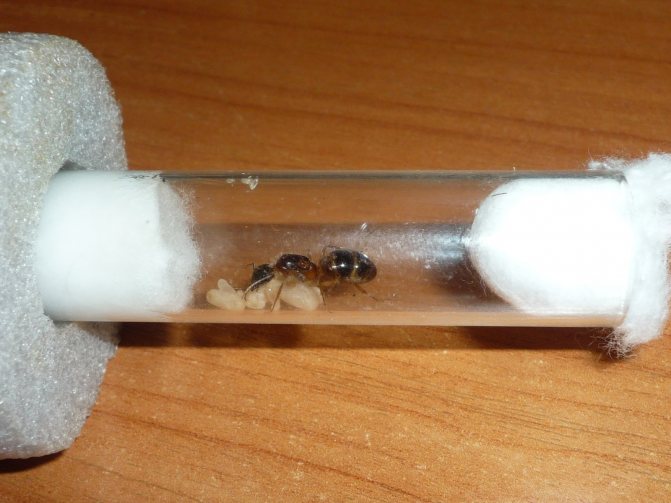

The initial stage of ant breeding - uterus and larvae in a test tube
You should also stock up on appropriate ant breeding literature so that you can handle the insects correctly so that they do not die. After all, you will need to gradually feed the offspring, move it to an artificial home formicarium filled with earth, and wait until the number of the colony reaches several dozen insects. You can already try to carefully move such an ant family into a pit prepared on the site. True, there are no guarantees that they will take root there. A shorter way is to dig an anthill in the meadow and try to move it to the garden. Finding an anthill in a meadow is not difficult, but pulling it out without damaging the uterus and offspring is not a trivial task. Just digging up a part of the anthill, transferring it to the site in a bucket and dumping it into a prepared hole is not a good idea, and if you are not an entomologist, it is better not to even try. Otherwise, you can waste the insect colony. After all, ants on human sites are frequent guests, and it might just be worthwhile to wait for them to come to you.
Harm to the garden
If you still have a desire to have ants in your garden, consider the risks.
- Ants spoil the roots.If insects have made their nest right in the garden, you may soon be missing a few plants, especially when it comes to seedlings. Ants often gnaw on tender shoots and sweet roots, thereby interfering with plant growth. In addition, the anthill can end up on your lawn, in the flower garden and on the path, which can damage the plants themselves and the appearance of the garden.
- Ants spoil trees. In addition to brown, black and red forest ants, woodworms can also grow in the garden. And this means that your fruit trees, as well as a country house, if it is made of logs, may be in danger. If the house has a wood-burning stove, the ants can ruin the woodpile.
- Ants breed aphids. The greatest damage from ants is not caused by themselves, but by their so-called pets - aphids. These small pests suck sap from plants, causing them to wither and may even die.
What is it built of
Most people think of an anthill as a heap of rubbish collected from everywhere. Yes, indeed, in the forests, ants mainly build their houses from needles, pieces of bark, leaves and other improvised means. All of them are stacked surprisingly carefully - not every engineer can cope with such a task flawlessly. After all, needles, straw and other small building material are laid in such a way that during even the strongest downpour, only the top layer gets wet - no more than 2-3 centimeters. Most of the water gently rolls down the surface of the anthill, without causing problems for the inhabitants.
However, in some cases, they prefer to take a ready-made rotten stump. Of course, this is only the upper part of the anthill itself. There are only a few important rooms here, most of them are hidden deep underground - we will talk about this a little later. This is not at all accidental - in cold climates, the earth warms up rather slowly, and ants, like any insects, are highly dependent on the ambient temperature. But the above-ground part of the sun's rays warm up much faster, providing comfort and high productivity to the inhabitants.
But sometimes an anthill from the outside looks just like a small hole in the ground. Most often, these can be seen in the steppe or desert. This is not an accident - if the soil freezes here, it warms up very quickly - spring in such places is usually early, and summer is very hot. Therefore, it is more important for ants not to warm up their housing as soon as possible, but to get rid of excess heat. Scientists have found anthills in the deserts that go 10 meters deep! It has the moisture it needs to live, and the sand never gets too hot.
Ant house appearance
From what ants build an anthill, you can see from the outside - dry twigs, sticks, blades of grass, leaves, breasts of the earth, moss and other building materials that hardworking insects can bring.
From above, the house looks like a cone-shaped embankment with small holes - entrances. This shape allows the anthill to warm up well in the sun, not get wet in the rain, and get oxygen.
The anthill rises above the grass so that the surrounding vegetation does not block the sun's rays. Over the years, they build it up to several meters in height. Raindrops, falling on the numerous layer of sticks, twigs, leaves, roll down, do not penetrate inside. The open entrances, guarded by a large army of soldiers, serve as ventilation shafts through which air is constantly circulated.
Anthill appearance Scientists have recorded the largest structure in the Tomsk region - 3 m in height, 5 m in diameter. The anthill was supposedly built for 20 years.
Main device
Now let's move on to how the anthill works. The most visible layer is the protective layer. A thick layer of needles, straw or pieces of leaves, which absorbs some of the moisture, taking most of it outside the dwelling.At the same time, it acts as a thermal cushion, protecting against excessive overheating and hypothermia. Directly below it is a kind of bathhouse - ants gather here in spring and early morning to warm up, restore functionality and start daily work.
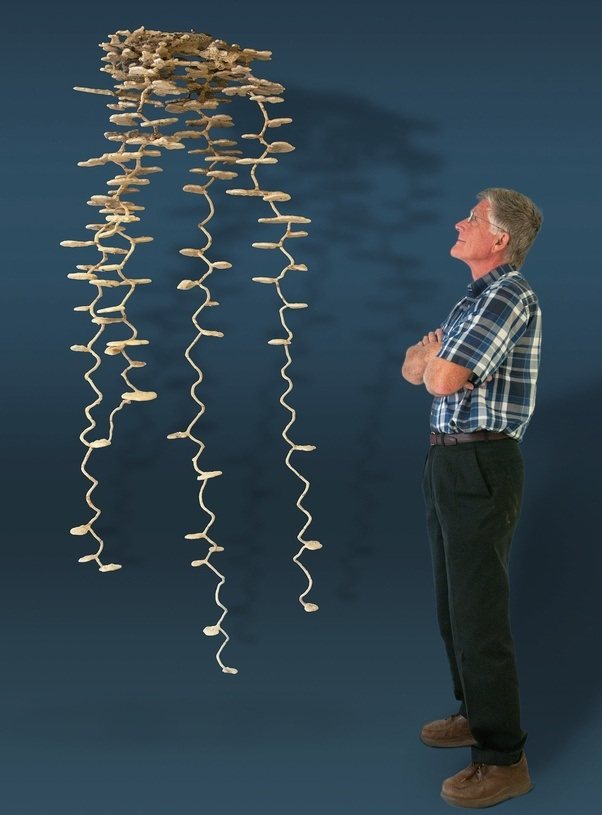

There are outputs - from several to a couple of dozen. In the desert or steppe, the distance between them can reach 2-5 meters. In an ordinary forest anthill, the exits are much more compact. They lead to common corridors that connect many chambers: food storage, uterus housing, nursery for storing larvae and eggs, cemetery where dead ants belong, and waste. Many of them are duplicated (except for the dwelling of the uterus, it is always only one per anthill). But there may be several warehouses for food, cemeteries, nurseries. This is justified for several reasons. First, to make it easier to choose the right one - the one that is closer. Secondly, in case one gets damaged, there will be a few more spare.
Now that you know how an anthill is built, a description of the individual ants is worth giving. Then each reader was able to appreciate the complexity of this society.
Hierarchy
The anthill is usually headed by the uterus is a large insect, which continually lays eggs, providing new residents to the community. Worker ants solve the daily tasks of caring for eggs and pupae, finding food, and repairing an anthill. Soldiers stand guard at the entrances to the dwelling and cut off strangers. Males and females participate in the reproduction process.
The soldiers
Ants warriors are a separate subspecies of ordinary workers, differing from the latter in slightly larger sizes. In addition, such an ant the mandibles are more developed, muscles which occupy most of the head. In some species of ants, due to the characteristic structure of the head, the soldiers have lost the ability to eat independently - as a result, the workers have to feed them.
The main function of the soldier ants in the community is the protection of the territory and the anthill from the penetration of enemies into it, the protection of foragers who deliver food. In addition, soldiers with their powerful jaws help to dismember the prey into several parts, if the workers cannot carry it away on their own.
The role of a working ant in the family and structural features
The builder ants are the first species which appears at the uterus after the foundation of a new anthill. They are the ones who build the colony, prepare food and take care of the eggs and pupae. In a developed anthill, workers prevail among all individuals.
REFERENCE! The distribution of professions among ant workers depends on their general condition and mental inclinations.
So, initiative insects with a good reaction become scouts and hunters, and slow and unhurried individuals go to graze aphids and collect sweetish secretions. In addition, the profession changes with aging.
Juveniles usually do work inside the nest - looking after eggs, females, build new passages and chambers.
In the event that a significant part of the workers of one profession perishes - for example, they are destroyed by birds or as a result of chemical treatment, their duties are redistributed among the remaining inhabitants of the anthill.
What ants do
Very few people who are not seriously interested in this issue guess how an anthill works. But this is a really complicated society.
To begin with, it is worth noting that all ants are divided into three groups: the uterus (she is the queen, the only one in the anthill), males (up to several dozen, are needed to fertilize the uterus) and workers. It is about the latter that it is worth telling in more detail.
Some experts identify up to ten specialties, which include working ants. Moreover, each of them is engaged in his own business from birth to death, has a certain structure for this. For example, soldier ants have a particularly large head - if necessary, they can block the passage with it, preventing the enemy from entering a long corridor. Nurse ants are distinguished by very delicate antennae, allowing them to catch the slightest movements in pupae and eggs. The midwives who look after the queen are very similar to them. They feed her, remove waste products, stroke her, helping to lay new eggs (several thousand a day). Loader ants have powerful necks and legs, thanks to which they lift a huge load for their body. Builders have glands that produce sticky saliva, which is used to hold the building material together.
And this is not counting highly specialized ants that are found in specific anthills, depending on the direction of their economy.
Interesting life inside
From the very birth, there is a division into castes.
- Most of the family are working ants. One half provides coziness, comfort inside the structure, the other - brings food from the external environment, is engaged in the construction of a house outside.
- At the head of the hierarchy is the female, which is also called the uterus, the queen. Once fertilized at a young age, it gives offspring throughout its long life. Finds a place for the future anthill. In 14 days, full-fledged ants appear from the eggs, mainly a working clan. They are taken for the structure.
- A small part of society is young males. Their lot is not so happy. After fertilization, young females die within 2 weeks.
We suggest that you familiarize yourself with: What nits look like in children
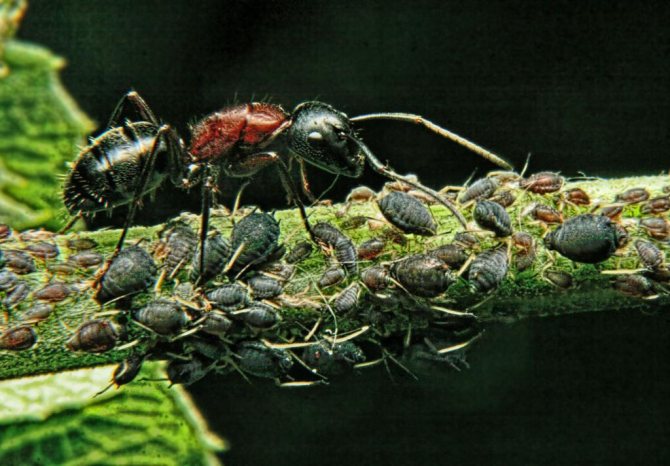

Each ant has its own individual scent. All inhabitants of a single anthill also differ in a specific aroma. By smell, society distinguishes its inhabitant from someone else's. With the help of specific aromas, they report the finding of food, danger, find each other heterosexual individuals for fertilization. Life of an anthill There are more than a dozen "professions" in ant society:
- scouts;
- warriors-invaders;
- guard soldiers;
- builders;
- orderlies;
- nannies;
- earners;
- shepherds, milkers;
- transporters;
- nurses;
- guards of food, nectar;
- midwives.
Life in an anthill continues for years. If there is a threat of collapses, damage, a family of ants begins to build other housing in the immediate vicinity, in order to more conveniently drag stocks, eggs, larvae.
The device of an anthill resembles a large city with a developed civilization, division into societies, a clear distribution of responsibilities. A simple structure on the outside is the most complex structure on the inside.
Amazing unity
After reviewing the structure of the anthill and the description of its inhabitants, the reader will be interested to learn about their unity. The entire population acts as a single organism (this is already known to many).
But as additional information, it is worth giving an illustrative example. Specialists have seen more than once how ants are fighting fires that engulfed their homes. They simply extinguish the fire using the formic acid produced by the worker ants. Everyone is able to allocate only miserable fractions of a milligram - such a blow does not care for fire. However, when tens and hundreds of thousands of individuals come into play at the same time, a small flame cannot resist - it really gets lost, extinguishes, without causing damage to the anthill that it could not survive.
From rags to riches, or career growth
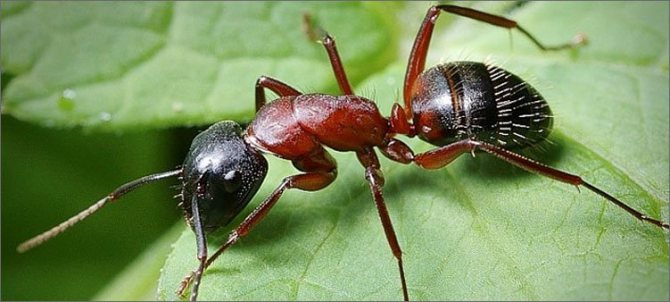

Most ants at a young age often try to find themselves in different professions, working as a nanny, then as a builder, or as a shepherd.They are looking for themselves, so to speak, just like us people! Those who “like a daisy” cannot decide in any way, the role of handymen is destined, since they do not stand on ceremony with lazy people and losers.
Having worked for about a year - three years, experienced and qualified, they fall into the "personnel reserve", always ready to start eliminating accidents and disasters. From the reserve they are appointed to other positions.
In the struggle for a place in the sun, they know how to survive a competitor. To do this, ants - applicants for the position jump on each other, trying to be higher, walk on their outstretched legs and bite with their jaws.
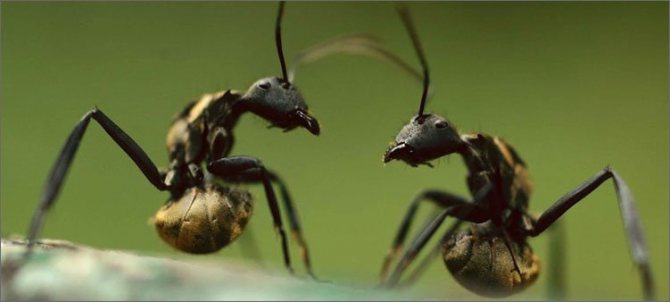

The triumphant forces the competitor to bend in the "suitcase position", drags him into the anthill and throws him somewhere so that he does not interfere with his career. Doesn't it look like anything?
Do you know that?! Workers love and know how to relax. They do this within the walls of the house, falling into nirvana, swinging on their legs in a dream.
How an anthill appears
When we talked about the structure of the anthill most often, it is worth mentioning how it appears in general.
Most often, the ancestor is a lone uterus. Immediately after leaving its native anthill, it is fertilized by males and flies away, several kilometers away. Here she chooses a suitable place - a rotten log, a stump, just a patch of soft, slightly damp soil. It buries itself so as not to become prey to other insects or birds, after which it lays eggs. The young uterus takes care of the former on its own. At this time, she does not even eat. However, once the first worker ants hatch, everything changes. Part immediately proceeds to caring for the queen. Others begin to build an anthill. Still others go hunting in order to feed themselves, the uterus, as well as other relatives employed in other spheres of labor. Every year the anthill becomes more and more, the population is growing rapidly. Over time, young fertilized uterus will also fly out of it in order to repeat the whole procedure from the beginning.
What to do if you get bitten by an ant
And finally, let's talk about what to do if, during a difficult struggle, several small ants did not hesitate to "bite" your hand or other part of the body. In temperate latitudes, an ant bite is not dangerous, but can be quite painful. A person is usually bitten by warrior ants with a large head and powerful jaws.
A slight itching caused by a single bite disappears after a few hours and does not pose a danger to humans. It is much worse if an allergic reaction develops, the signs of which are the following symptoms:
- the appearance of swelling, blisters, itching;
- extensive redness of the skin, accompanied by pain;
- nausea, shortness of breath, headache, loss of consciousness.
The bite of one soldier ant is not terrible for the inhabitants of the middle lane
Treatment for ant bites is as follows:
- wipe the bite with a drug containing alcohol;
- Make a baking soda compress to relieve itching.
- remove the swelling that occurs with several bites using a compress from steamed birch leaves or raw potato gruel;
- take antihistamines;
- if severely injured, consult a doctor.
As you can see, it is quite possible to completely get rid of ants. Do this without any regret, because real pests settle on your site, which, unlike their forest counterparts, are not useful insects, but only harm your plantings and food supplies.
Two tiers
If you study the structure of the anthill in a section with a description, you will notice that it is populated unevenly. It depends on the seasonality. In summer, the upper layer (aboveground) is most densely populated, as well as the upper floors of the underground - they practically do not enter the lower ones (only sometimes, to carry part of the supplies). In the cold season, everything changes. All supplies, as well as larvae and eggs, are transferred deep underground.This allows the ants to avoid hypothermia - at a depth of 1-2 m it is always warmer than on the surface, where the temperature can drop to -30 degrees and even lower.
Effective methods of dealing with black ants
Chemical preparations that are made in industrial plants and are allowed for use in garden and backyard plots will help to remove pests, for example, the most effective are: Muratsid, Anteater, Delicia. These are bulk preparations that are dissolved in water and then watered with problem areas.
Traps
There are also baits that are applied to various surfaces, cardboard boxes, boards and put them where there is a massive accumulation of black insects. Sticky paper or plastic baits work in the following way, getting on the sticky surface, the ant sticks. But such tapes are short-lived and do not have a very long shelf life. Under the influence of the sun and rain, they lose their properties.
Chemicals
To combat aphids and ants, you can use chemicals that are designed to spray plants. For example, these drugs include: Bison, Alatar, BI-58. A solution of such drugs, getting on the leaves, makes them poisonous and also helps to kill ants. If you constantly carry out chemical irrigation of the site with the listed drugs, then you can get rid of various pests in these areas.
Effective chemicals include gels such as the Great Warrior.
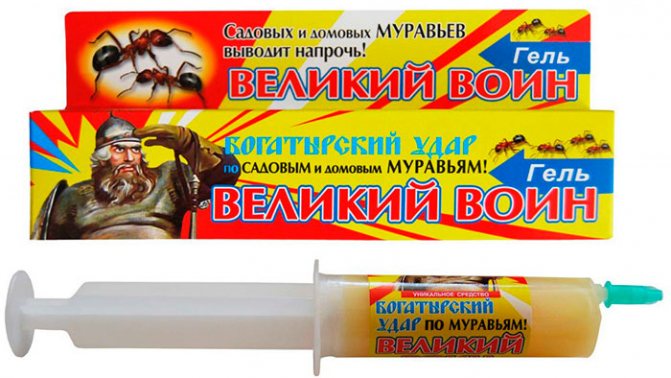

Folk remedies for black ants in the garden and vegetable garden
It is undesirable to get carried away with the use of chemicals, as you can harm the future harvest and your health. You have to use such drugs when no other means help. As a non-chemical way of fighting ants, folk remedies will help well:
- saline solution;
- sweet syrup;
- steep boiling water;
- vegetable oil;
- acetic, citric and boric acid;
- semolina and wheat groats;
- gasoline, or kerosene;
- plants with a spicy smell.
One of the simplest tips is to simply pour boiling water over the passages in the ground.
The black ant does not tolerate strong odors. The scent of tansy, as well as the smell of crushed leaves of tomatoes, mint, wormwood will drive uninvited guests from your territory. However, this method does not exterminate all of them, but only you can drive them away from your garden for a short time.
The ash, which remained from the burnt fire, will not only solve the problem of the "invasion of ants", but will also fertilize the earth. A fairly effective method of dealing with this insect is watering problem areas of the garden with urine. After such treatment, insects leave forever.
Using poisoned baits is more effective than previously proposed methods. Such baits are prepared at home, but you should be very careful, since if a toxic substance enters the human body, you can be seriously injured.
Boric acid is suitable for pest control. In boric acid, you need to add something sweet, for example: honey, sugar, jam. We place this mixture in the habitats of the villains: berry bushes, fruit trees. After such manipulations, the intruders disappear.
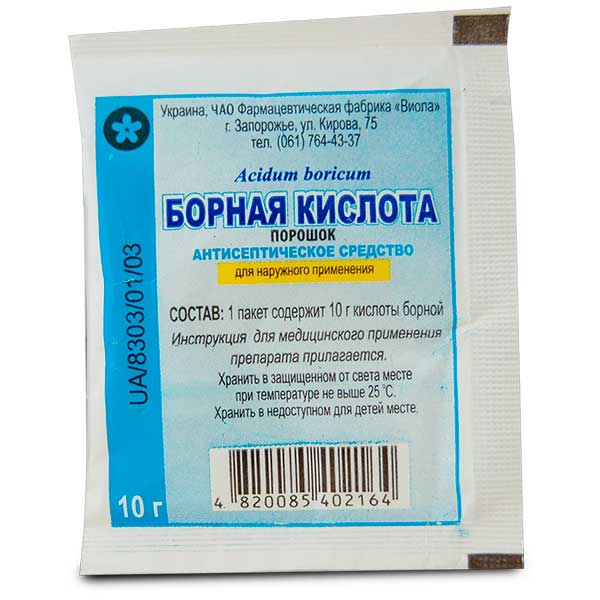

There is another effective, but not quite common way to fight ants. You just need to pour dry millet or other cereals on top of the ant hill. It is unknown why, but the ants disappear. To prevent the birds from pecking at the cereal, before it takes effect, it is necessary to sprinkle dried grass, straw or foliage over the spilled cereal.
It is also an effective method with salt, but it can harm plants and reduce the fertility of the land. They are also afraid of acid, the use of a vinegar solution, or citric acid, will show its result the next day.
The use of waste sunflower oil, gasoline, kerosene is also suitable for fighting garden ants. If your garden is very crowded with ants, try using several methods at once, combining them.
Various political and economic systems
Not everyone knows, but in different anthills - depending on the breed - there may be different economic and even political systems. This is not a joke at all. Scientists have repeatedly recorded real wars between anthills. Moreover, they are always provoked by certain types. They attack neighbors, partially destroy the guards in order to break into the premises with eggs and larvae. Then they drag them away, raising them in their own anthill as slaves - most of the work is done by the captured individuals while the owners continue their aggressive wars.
There are also cases of animal husbandry. Ants really breed peculiar cows - aphids. In the morning they drive her out of the anthill onto the leaves, protect her from ladybirds and other dangers, and in the evenings they return her back to the “stall”. For this they receive sweet milk, which causes so many problems for gardeners - leaves die because of it.
Finally, you can see the farming ants. They chew on small leaves, mixing in the mouth with fungal spores, and then spread them in special rooms where mushrooms germinate and serve as food for the entire colony.
Ant control methods
There are various ways to kill ants:
- Using poisonous baits,
- scaring away with various odorous substances,
- destruction of habitats,
- fight against aphids,
- creation of obstacles in progress.
Biological preparations
It is possible to completely destroy aphid colonies locally using modern biological pesticides. Substances created on the basis of special molds are not dangerous for humans, bees, animals, and many useful insects. But they are very effective in removing any aphids. These are Fitoverm and Akarin preparations, as well as Iskra Bio. Spraying can be carried out at any time of the season (only not prophylactically, but directly against pests). Flowering, ovaries, ripe harvest are not a hindrance. If you destroy the first colonies of aphids along with the queens, then the whole season will be clean. Thus, the number of ants will also decrease.
Destruction of anthills
If you know the specific location of the ant colony in the summer cottage or nearby, you can try to destroy the dwelling. This is usually a temporary measure. The queen-womb is hiding at a distance of 100 centimeters or more from the surface of the earth. If she manages to survive, then very soon she will revive an extensive family in the same place or nearby. However, you can gain time by using a variety of recipes for fighting from the arsenal of folk wisdom: deep digging, making fires, watering an underground shelter with boiling water or water with vinegar, salt, lime, kerosene.
Scare away the smell
All species of ants actively communicate with each other and transmit a lot of important information with the help of odorous pheromones secreted by adults, so they try to avoid alien pungent odors. Gardeners who do not recognize chemicals can try to scare off ants with various naturally occurring scents.
Here is a far from complete list, developed by the experience of several generations: birch tar, vinegar, cinnamon, orange peels, garlic, wormwood, mint, parsley, celery, anise, fennel, red and black elderberry.
How to see everything with your own eyes?
Many parents, noticing the interest of their children in ants, wonder how to demonstrate the structure of an anthill to children. Of course, you can watch various programs, but this is not at all the same.
Fortunately, special or formicaria can be easily found on the market nowadays. They can be made from a variety of materials.It is enough to plant the uterus found here, from time to time to feed it with insects, sugar syrup or other suitable products. After a few months, you will become the owner of your own anthill. Transparent walls make it possible to see everything that happens inside. It is very interesting for both children and adults to follow him. A common interest will surely bring your family closer together, allow you to find a new topic for communication.
The benefits of insects
Small ginger predators not only "work" as orderlies. They also perform other useful functions:
1. Participate in the reproduction of plants.
Ants are omnivorous. Therefore, they also have plant seeds in their diet. An ant collects them far from its anthill. And drags home. But it doesn’t carry all the booty. This is how the seeds are spread throughout the forest.
2. Pollinate flowers.
Ants love treats. By eating nectar, they pollinate the flowers.
3. Increase soil fertility.
Each of us, for sure, saw what deep paths these small insects can make. They loosen the soil to a depth of half a meter! Constantly mixing it with rotted leaves, blades of grass, remains of insects, ants enrich it with organic and mineral elements, aerate it.
Look at the plants near the nests: they grow very quickly, they are healthy and lush, bright green.
4. Formic acid is a medicine.
Since ancient times, people have been treated with ants. They made ant infusions, oil extracts. They allowed these insects to bite themselves and their children. Formic acid helps to get rid of rheumatic pains and neurodermatitis, to cope with colds and tuberculosis, with anemia and multiple sclerosis. In ancient China, dried insects were eaten to preserve beauty and youth.
For the forest to be healthy, in order to maintain the ecological balance, one large (about one and a half meters in diameter) active anthill per hectare of area is enough. If the nests are small, then, accordingly, there should be more of them.
